This is going to sound like a repeat of a recent story but it is not – dredging just seems to be an application that Hydra-Tech Pumps are being called on to do more and more lately. This story is out of New Zealand – our friend Doug Kirby, who is two years new to Hydra-Tech Pumps as a representative and distributor of our products, is involved in exactly the kind of dirty jobs you would expect with a name like Slurry Services. 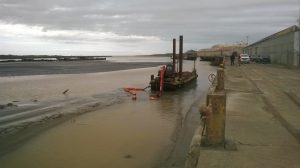
In preparing for a significant dredging project on the west coast of the north island of New Zealand, Doug ordered a 6” Sand / Slurry Pump (S6CSL) from Hydra-Tech Pumps as the key component in their approach to the job. The project they were preparing for involved removing river sediment from a marina to create a channel to allow better access to the ocean for the Coast Guard rescue boat and recreational boats as well. They had been launching off of the beach and this work would prevent this and make the boaters’ lives a little easier.
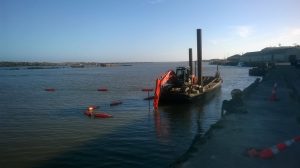 Doug and his team put together their barge / excavator / pump set up (for anyone who has ever watched Discovery Channel’s Bearing Sea Gold this concept is familiar) and got to work. The biggest challenge was ripping up the bed – a mixture of compacted fine clay and sediment as well as larger solids and debris. They worked to tear up the bed and move the mixture to the pump and operated only when the tide was going out so that the sediment wasn’t coming back to where they were working. The water and solids (less the tree branches and other larger debris) was pumped over 1000 feet away.
Doug and his team put together their barge / excavator / pump set up (for anyone who has ever watched Discovery Channel’s Bearing Sea Gold this concept is familiar) and got to work. The biggest challenge was ripping up the bed – a mixture of compacted fine clay and sediment as well as larger solids and debris. They worked to tear up the bed and move the mixture to the pump and operated only when the tide was going out so that the sediment wasn’t coming back to where they were working. The water and solids (less the tree branches and other larger debris) was pumped over 1000 feet away.
Despite the very difficult dredging conditions they averaged 32 cubic yards (86 tons) of solids per hour from day 1. The project was a success and has led to additional opportunities based on their short set up time and efficiency in getting the job done. The next job is on the east coast of the island where the sediment is primarily sand and flows more easily, here over a similar pumping distance they expect to move in excess of 60 cubic yards (162 tons) of material an hour.
Applications like many other things seem to come in waves. Right now it appears as though Doug and many of our other marine / diving customers are putting Hydra-Tech Pumps to work to earn dredging jobs and exceed expectations!
Don Coleman of Blue Diving & Salvage LLC in Mobile, Alabama had quoted a big opportunity and wanted to change how he was going to approach the job. Don’s company provides inland / onshore commercial diving services along the Gulf Coast and had recently submitted a proposal to a condominium association for some dredging work along the inlet to their private marina. The requirement? Remove an average of 30” of coarse sand from an area 220’ x 20’ at a depth of up to 5 feet so that boats aren’t scraping bottom on their way in and out of the marina. Deliver the sand 90’ away and build an area of beach back up where some erosion has occurred.
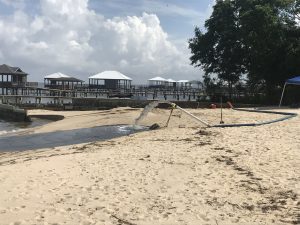
In the lead up to hearing from the association that he had won the business, Don contacted Hydra-Tech Pumps to help him to determine what different options we could provide to make this job go smoothly. He was familiar with Hydra-Tech Pumps because he has occasionally rented for other jobs through some of the rental companies. After a number of phone calls and emails, Don had information on virtually every kind of 4” pump we manufacture – this was something that he thanked us for later. He said that it meant a lot that we took the time to go through the options and explain the technical differences in features, construction, applications and price on all of the different pumps without rushing him or abandoning him in the learning process. Don placed an order for a ductile iron 4” pump at almost the same time that he heard that he had been awarded the job at the condo association. Hydra-Tech built the pump in three days and shipped it to Blue Diving and Salvage on the fourth.
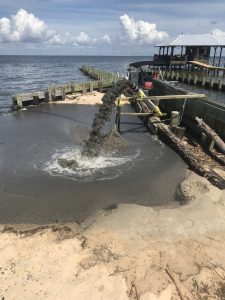
Within a week they were on site and ready to go. The Hydra-Tech pump was suspended off of the front of the boat – the strainer was swapped out for a flange and fitting to get them to a length of suction hose and a nozzle that the diver would hold. In two and a half days and about 22 hours of run time, the diver and the pump moved over 400 cubic yards of sand or a little over 18 yards an hour. The job was done and Don was happy with his pump and experience. The best surprise was still to come – when he removed the top from the volute to inspect the impeller for wear, it was minimal considering what the pump had been doing for 22 hours.
We hope that Don will be a Hydra-Tech Pumps customer for a long time. If you want to check out his website go to www.bluediverllc.com. How can Hydra-Tech Pumps help your company to get the job done?
Is your hydraulic power unit not working correctly, or how you believe it should be working? Here are a few steps to make an initial diagnosis of what may be causing a low or no pressure situation with a Hydra-Tech hydraulic power unit system.
1) Make sure the hydraulic hoses are not connected.
2) Start the unit with the oil cold
3) Activate the hydraulics by engaging the HYDRAULIC CONTROL VALVE (H.C Valve) by turning it clockwise until it stops
4) Read the high pressure gauge.
5) If the pressure does not build to at least 2200psi (HT25DD and above or 1100psi for HT20G and below), then…
6) Stop the engine, remove the reservoir cover and locate the relief valve
7) Look to find the discharge pipe that comes off the relief valve body and dumps into the tank.
8) Start the unit (with the oil cold) and engage the HYDRAULIC CONTROL VALVE (H.C Valve) by turning it clockwise until it stops.
9) Reach into the tank and feel if any oil is coming out of the discharge pipe off the relief valve.
10) If oil flow IS coming out, the relief valve cartridge may have some debris in it and will need to be removed and cleaned. Or, the steel tubing going from the relief valve to the H.C. Valve may be cracked or loose and needs repair. Or, the aluminum block housing the relief valve cartridge may be cracked.
11) Check and or correct all of these conditions and return to steps 2-9, then…
12) If the proper pressure is not being attained, and/or if no if no oil is flowing from the discharge pipe the hydraulic pump is probably worn out.
NOTE: Noises in the hydraulic system are usually from cavitation due to a bad hydraulic pump. This is usually caused by dirt or contamination getting into the system. When contamination and cavitation occurs, the pump will get hot and the pressure will usually go up and down with the engine speed. If the hydraulic pump is replaced, the reservoir will have to be drained and thoroughly cleaned, the suction strainer will need to be cleaned, the system will need to be purged of any contaminated hydraulic oil, the return filter must be replaced and the case on the hydraulic pump filled with oil BEFORE re-starting the engine.
If your power unit is still not working correctly after this, please contact us for additional help!
https://conta.cc/2JzVtQ3
Problem:
There are some applications where using a centrifugal pump is best suited for the job but the suction lift limitations of centrifugal pumps create a problem.
A typical centrifugal pump without vacuum assist priming can reasonably lift water only 15-20 feet before running into cavitation issues and loss of performance. Adding a vacuum assist primer to remove air and lower the atmospheric pressure in the suction line can increase the effective suction lift to an absolute maximum of 34 feet (at sea level).
At these high suction lifts there is still a significant loss of pump performance.
What do you do if the suction lift exceeds these limits?
The Hydra-Tech Solution:
Adding a Hydra-Tech hydraulic submersible pump to lift the water to the centrifugal pump will solve the high suction lift problem.
By lifting the water to the centrifugal pump you also remove the performance loss issues caused by high suction lifts.
Click on this link to see an image of how this works: High Lift S6300
In this application the customer has an offshore fire-fighting platform that is elevated 90 feet (27 Meters) above the sea level. The high-pressure centrifugal pump is the best pump for fire fighting. The light suction lift does not allow the centrifugal pump to pull water from the sea.
By adding the Hydra-Tech S6300 12” pump to the suction line they were able to overcome the high suction lift problem.
Hydra-Tech Pumps provided a Hydraulic Kit that uses the existing engine power to drive the S6300 Pump. This was a win-win for the customer and proves the concept of overcoming high suction lift problems.
Problem:
There are some applications where using a centrifugal pump is best suited for the job but the suction lift limitations of centrifugal pumps create a problem.
A typical centrifugal pump without vacuum assist priming can reasonably lift water only 15-20 feet before running into cavitation issues and loss of performance. Adding a vacuum assist primer to remove air and lower the atmospheric pressure in the suction line can increase the effective suction lift to an absolute maximum of 34 feet (at sea level).
At these high suction lifts there is still a significant loss of pump performance.
What do you do if the suction lift exceeds these limits?
The Hydra-Tech Solution:
Adding a Hydra-Tech hydraulic submersible pump to lift the water to the centrifugal pump will solve the high suction lift problem.
By lifting the water to the centrifugal pump you also remove the performance loss issues caused by high suction lifts.
Click on this link to see an image of how this works: High Lift S6300
In this application the customer has an offshore fire-fighting platform that is elevated 90 feet (27 Meters) above the sea level. The high-pressure centrifugal pump is the best pump for fire fighting. The light suction lift does not allow the centrifugal pump to pull water from the sea.
By adding the Hydra-Tech S6300 12” pump to the suction line they were able to overcome the high suction lift problem.
Hydra-Tech Pumps provided a Hydraulic Kit that uses the existing engine power to drive the S6300 Pump. This was a win-win for the customer and proves the concept of overcoming high suction lift problems.
https://conta.cc/2GbPW0L
The phrase “Made in the USA” gets tossed around quite often but what does it really mean? If you have some free time and are looking for some exhilarating reading go to the Federal Trade Commission’s website and you can read pages of detail about complying with the Made in the USA standard. Ultimately what it means is “all or virtually all” product has been made in the United States. How about we tell you what it means to Hydra-Tech.
Hydra-Tech Pumps was founded in 1977 in Mt. Holly, New Jersey and moved to Nesquehoning, Pennsylvania in 2007. We believe in supporting small and local businesses so we use local, domestic suppliers as much as we are able for anything we source from the smallest fasteners and fittings through a huge 400 horsepower diesel engine and all items in between.
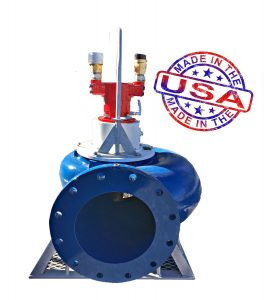
The area where we really utilize the Made in the USA statement is castings. Of the approximately 130 cast parts we source to make the wide variety of aluminum, ductile iron and stainless steel pumps we manufacture, almost 97 percent are purchased from foundries within a 100 mile radius of our Nesquehoning location. Anyone who has been involved in manufacturing of any kind knows the significance behind this. Hydra-Tech Pumps could send all of these parts overseas and probably cut parts costs by 50% – 75%. However, challenges arise if a problem comes up when you can’t get in your car and visit a foundry in person and look at a pattern and their processes. Lead times are longer and logistics challenges are more significant when that skid of aluminum volute castings are coming from the other side of the world instead of the next county over. And based on the FTC’s guidelines I’m sure that would mean we couldn’t say “Made in the USA” anymore if went down that road.
All of our 22 employees are proud to promote and live by the Made in the USA phrase. We believe that it still means something to our customer base and to any new prospects as well.
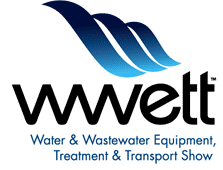 Hydra-Tech wrapped up another great WWETT Show on Saturday afternoon before packing up and returning home on Sunday – thanks to all of our customer and friends who made it to the show and stopped by to visit! For those of you wondering what the WWETT Show is – WWETT stands for Water & Wastewater Equipment, Treatment & Transport. The show was original called the Pumper Show from its inception until about 5 years ago when they made the name change. Originally the Pumper Show was primarily focused on septic tank pumping professionals but the show has evolved through the years to include so many more applications and professions that it was renamed.
Hydra-Tech wrapped up another great WWETT Show on Saturday afternoon before packing up and returning home on Sunday – thanks to all of our customer and friends who made it to the show and stopped by to visit! For those of you wondering what the WWETT Show is – WWETT stands for Water & Wastewater Equipment, Treatment & Transport. The show was original called the Pumper Show from its inception until about 5 years ago when they made the name change. Originally the Pumper Show was primarily focused on septic tank pumping professionals but the show has evolved through the years to include so many more applications and professions that it was renamed.
Hydra-Tech was one of 624 exhibitors showing their hydraulically driven submersible pumps and power units in the Indianapolis Convention Center for the two and a half day show that drew more than 12,000 visitors. At the show we saw some customers we expected to see, as well as some surprises and new prospects as well. We helped some visitors decide if our pumps would benefit them, and if so, how best to power them and maximize the benefit of hydraulic submersible dewatering pumps. We saw our old friend James Penner from In The Round Dewatering (see our blog post last year about working with James http://hydra-tech.com/one-thing-leads-another/.
While it did rain most of the time that we were in town, we managed to enjoy some of Indianapolis’ great restaurants and bars after the show. We have been to our fair share of trade shows in the last 11 years in a number of different cities. And while Indianapolis doesn’t offer the over the top kind of excitement of the Las Vegas Strip, we have always enjoyed Indy because everything is right downtown within walking distance from the hotel and convention center. As well, like Minneapolis / St. Paul, there are a number of connectors downtown that allow you to move from block to block and cross streets without getting wet in the rain.
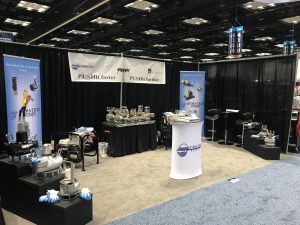
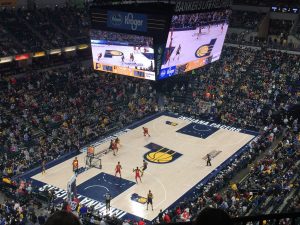
We will be back next year for WWETT Show 2019 – will we see you there?
Since its beginnings over 80 years ago, the Contractors Pump Bureau’s primary reason for existing has been to serve pump guys that design, produce, sell, rent and buy portable contractor and dewatering pumps.
You can count among the CPB full members, some of the largest companies and some of the most notable personalities in the pump industry. Gorman-Rupp, Global, Xylem, Holland Pump, Hydra-Tech Pumps, Tsurumi, Mody, Sulzer and Thompson Pump are represented in the CPB by people like Rod Mersino, Jeff Gorman, Sam Mody and Bill Thompson. Associate members are those companies that manufacture some of the major components used by pump companies and names like Honda, Deutz, LOFA Industries and Hatz.
The CPB serves pump people by:
- Developing and maintaining industry consensus standards for pumps and auxiliary equipment.
- Promoting the common interests of the pump industry as a whole
- Creating and disseminating Best Operation Practices, Safety related support documents and informational publications on pump selection.
- Looking forward to find ways to improve customer service and knowledge and make products safer and more efficient.
The following Tools and Standards, as developed by the CPB serve as valuable aids to engineers and others tasked with choosing the correct pump for most pumping situations:
- The Pump Selection Guidebook helps choose both the right style and size pump for the job. And, it serves as an introduction to all types of pumps for those new to the industry.
- The CPB Pump Efficiency standard, when employed by pump producers, allows for more transparent comparisons of pump performance and efficiency as it seeks to standardize the ways in which these technical details are represented on a performance curve.
- The Noise Level Standard, which is included in the Portable Pump Operator Safety Manual, is a long standing benchmark which details the acceptable noise levels for portable dewatering pumps when they are operated in noise sensitive areas.
- Member companies can proudly display the CPB logo on their pumping equipment, and it serves users by providing quick visual proof that the pump they are using is produced to the high standards required by the Contractor’s Pump Bureau.
Membership in the group is open to members of the Association of Equipment Manufacturers who in turn are pump manufacturers or major component suppliers to pump companies. Among other benefits, members of CPB can participate in and use data from the Statistics program which collects and categorizes historical pump sales for the North American market, including Canada and Latin America.
If you manufacture pumps or are a key supplier for one or more pump companies, you can learn about membership by searching the web for the Contractor’s Pump Bureau. Or, if you are a pump buyer, specifier or user, give yourself one less thing to worry about by looking for the CPB logo before making that next investment in a pump product.
www.aem.org/groups/product-specific/contractors-pump-bureau-cpb
